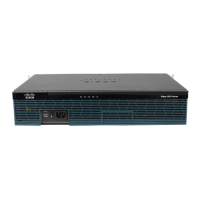29
Cisco 3900 Series, Cisco 2900 Series, and Cisco 1900 Series Integrated Services Routers Generation 2 Software Configuration Guide
Configuring Ethernet CFM and Y.1731
Performance Monitoring on Layer 3 Interfaces
This chapter provides procedures for configuring the network interface device functionality, Ethernet
data plane loopback, IEEE connectivity fault management, and Y.1731 performance monitoring, and
contains the following sections:
• Configuring a Network Interface Device on the L3 Interface, page 29
• Ethernet Data Plane Loopback, page 32
• CFM Support on Routed Port and Port MEP, page 38
• Support for Y.1731 Performance Monitoring on a Routed Port (L3 Subinterface), page 54
Configuring a Network Interface Device on the L3 Interface
Configuring a Network Interface Device (NID) enables support for the NID functionality on the router
without including a NID hardware in the network. This feature combines the Customer-Premises
Equipment (CPE) and the NID functionality into a physical device. The following are the advantages of
configuring the NID functionality:
• Eliminates a physical device.
• Supports both the managed CPE feature set and the NID requirements.
Note This feature is supported only if you have purchased the DATA technology package functionality
(datak9) licensing package. For more information about managing software activation licenses on the
Cisco ISR and Cisco ISR G2 platforms, see
http://www.cisco.com/en/US/docs/routers/access/sw_activation/SA_on_ISR.html.
Configuring the NID
The following steps describe how to configure the NID:
SUMMARY STEPS
Step 1 enable

